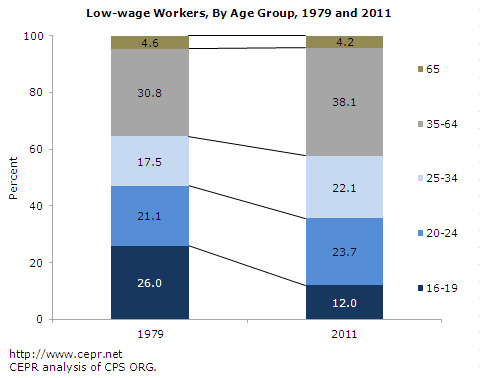April 02, 2012
Relative to any of the most common benchmarks – the cost of living, the wages of the average worker, or average productivity levels – the current federal minimum wage of $7.25 per hour is well below its historical value. These usual reference points, however, understate the true erosion in the minimum wage in recent decades because the average low-wage worker today is both older and much better educated than the average low-wage worker was in the past.
All else equal, older and better-educated workers earn more than younger and less-educated workers. More education – a completed high school degree, an associate’s degree from a two-year college, a bachelor’s degree from a four-year college, or an advanced degree – all add to a worker’s skills. An extra year of work also increases skills through a combination of on-the-job training and accumulated work experience. The labor market consistently rewards these education- and experience-related skills with higher pay, but the federal minimum wage has not recognized these improvements in the skill level of low-wage workers.
Even if there had been no change in the cost of living over the last 30 years, we would have expected the earnings of low-wage workers to rise simply because low-wage workers today are, on average, older and much better educated than they were in 1979, when wage inequality began to rise sharply in the United States.
Let’s start with age. Between 1979 and 2011, the average age of low-wage workers (defined as earning $10.00 per hour or less in 2011 dollars) increased 2.3 years, from 32.3 to 34.9. As the figure below shows, the rise in the average age reflects a big drop in the share of low-wage workers who are teenagers – from over one-in-four (26.0 percent) in 1979 to less than one-in-eight (12.0 percent) in 2011.

The educational attainment of low-wage workers has also soared. As the next figure demonstrates, the share of low-wage workers with some college education (but not a four-year degree) rose dramatically, from about one-in-five (19.5 percent) in 1979 to one-in-three (33.3 percent) in 2011. By 2011, almost one-tenth (9.9 percent) of low-wage workers had a four-year college degree or more, up from 5.7 percent in 1979. And the share with less than a high-school degree dropped by almost half, from 39.5 percent in 1979 to only 19.8 percent in 2011.

As we consider where to set the minimum wage going forward, it is not enough to calculate what level would preserve the purchasing power of this federal wage floor. We should also factor in reasonable rewards for the improvements in the educational attainment and work experience of low-wage workers. According to calculations we perform in a new CEPR issue brief, doing so would imply a minimum wage that is at least 9 to 14 percent higher than the inflation-adjusted value in 1979 or even higher relative to 1968. Using 1979 as a reference point, our calculations suggest a minimum wage in the range of at least $9.33 to $9.70 dollars per hour. While we cannot fully adjust for increases in age and education over the full period since 1968, applying a roughly similar methodology to the real value of the minimum wage in that year implies a 2012 minimum wage of at least $10.55 to $10.97 per hour.
(For the full issue brief, complete with a data appendix, click here.)







